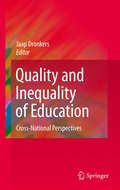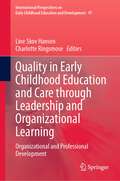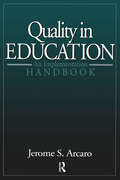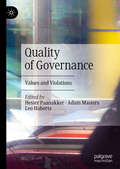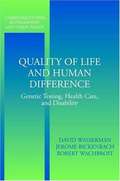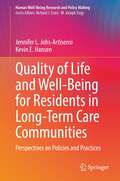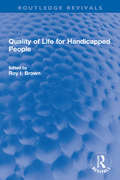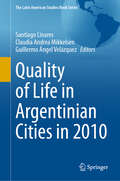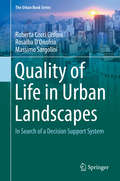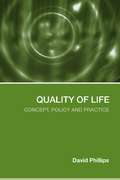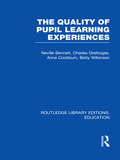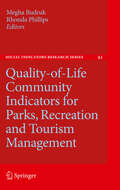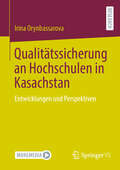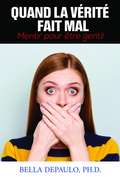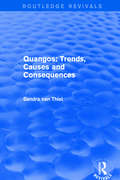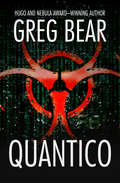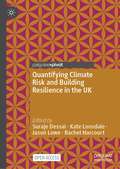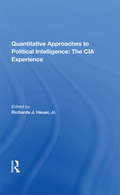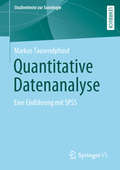- Table View
- List View
Quality and Inequality of Education
by Jaap DronkersThis cogent analysis of data on education and society from a variety of sources sets out to provide answers to scientific and policy questions on the quality of education and the way it relates to various forms of inequality in modern societies, particularly in Europe. The authors examine not only the well known cross-national PISA datasets, but also the European Social Survey and TIMSS, going further than many researchers by folding into their analyses economic, legal and historical factors. Most research up to now using the PISA data is restricted to educational research. Interesting as that educational question is, the chapters here use the PISA, and other data, to explore more profoundly the relationship between education and the various forms of inequality in European and other modern societies. The work comes from two different perspectives: one that looks at how the different characteristics of societies, their economies, and their educational systems influence the average educational achievements of specific groups of pupils, such as immigrants, in those societies; and a second, which explores how, and in what degree, the characteristics of schools, educational systems and labour-markets either hardens or softens differences in the educational outcomes of various groups of pupils. With a special feature of the book being its emphasis on comparing Asian and European countries, and with the content free of the political constraints that can often attend studies of these datasets, this book will be an vital resource for educationalists and policy-makers alike.
Quality in Early Childhood Education and Care through Leadership and Organizational Learning: Organizational and Professional Development (International Perspectives on Early Childhood Education and Development #41)
by Charlotte Ringsmose Line Skov HansenThis book provides insights in to how high quality learning environments in Early Childhood Education and Care (ECEC) develop, and how competent systems can support this. It builds on the knowledge that quality early environments shape the wellbeing and development of the child, and explores how communities of professional practice that support quality development are built. Acknowledging that the conditions for providing high quality pedagogical work depend not only on the individual teacher, but also on collaboration and organizational and professional development. The book draws on a range of theoretical frameworks and research that underline competent systems rather than individualized learning as a path to improve workforce quality and professionalization in the field of ECEC.
Quality in Education: An Implementation Handbook
by Jerry ArcaroAlthough hundreds of school improvement programs have been launched in the United States over the past quarter century, very few of them have been successful. The author of Quality in Education: An Implementation Handbook, an experienced quality expert who specializes in education, believes that many of these programs could have succeeded had their developers understood and applied the theories and methods of Total Quality Management (TQM). This book explains how to avoid the pitfalls that doomed previous efforts to failure, and apply TQM to build a strong foundation for success.Beginning with the basic concepts and tools, this book is your complete guide as you embark on your quality journey. The handbook explains the importance of making a commitment to change and establishing a shared vision of quality, and discusses tools and techniques for overcoming resistance and developing a quality culture. The book covers new methods you can use to manage change, and includes exercises to help you apply the ideas in your organization. Examples from successful schools demonstrate how Total Quality Management can be applied to every area of education, from classroom management to building maintenance.Quality in Education: An Implementation Handbook teaches you how to make fundamental changes to the way people in your district or school view education and themselves as educators. Using the principles and methods in this book ,you can realize the tremendous benefits of quality - continuous improvement in every educational process.
Quality of Governance: Values and Violations
by Leo Huberts Hester Paanakker Adam Masters"Quality of governance: Values and violations arrives at a time when governance faces new and often dire challenges and as traditional democratic values strain against the rise of authoritarian forms of populism and anti-government sentiment. This comprehensive volume considers these challenges from a variety of angles- transparency, bureaucratic pathologies, public values, sector relations- but at the same time manages a higher degree of integration than one usually finds in most edited volumes. The individual selections focus on topics of widespread interest but with new theories, analytical frameworks and insights. This book should be read by anyone interested the values bases of governance and in exploring good ideas about how to improve policy and management. The book serves a professional academic audience but could also prove quite useful as a text or supplementary book for graduate and undergraduate courses in public affairs."Barry Bozeman, Regents' Professor, Arizona State University, School of Public Affairs, USA. "Public governance matters. It touches almost every aspect of our lives, from the most mundane to the most important, the most commonplace to the most intimate. This book critically examines some of thorniest values and issues for governance in the 21st century -- democracy, legitimacy, accountability, transparency, integrity, professionalism, and more -- all of which are of crucial importance for practice and research on the quality of governance."Tina Nabatchi, Syracuse University, USA, Co-Chair of the Study Group ‘Quality of Governance’ of the International Institute of Administrative Sciences."This volume provides an up-to-date overview of key themes and theories about the quality of governance. Many of the field's most thoughtful scholars have contributed chapters on both the positive and problematic dimensions of good governance, providing fascinating insights in this important topic. Therefore, this book is a must read for all scholars, students, and practitioners interested in improving the quality of governance in their countries and institutions."Zeger van der Wal, National University of Singapore and Leiden University The Netherlands.This volume unravels the meaning of public values for the quality of governance, for good and bad governance, and examines their significance in governance practices. It addresses public values in context, in different countries, policy sectors and levels of governance. In a series of in-depth studies, a critical eye is cast over eight central values: democratic legitimacy, accountability, transparency, integrity, lawfulness, effectiveness (in terms of service quality), professionalism and craftsmanship, and robustness. How does for instance integrity or lawfulness contribute to the accomplishment and preservation of quality, and what happens if we fail to address it adequately? This unique exercise yields important lessons on the differences in normative interpretation and application of often abstract values in the demanding administrative settings of today. Practitioners, scholars and students of public administration, public management and political science will find the volume a vital resource for theory and practice.
Quality of Life and Human Difference: Genetic Testing, Health Care, and Disability
by Jerome Bickenbach David Wasserman Robert WachbroitThis study brings together two important literatures one volume. One concerns the role of quality assessments in social policy, especially health policy. The second concerns ethical and social issues raised by prenatal testing for disability. Hitherto, these two literatures have had little contact with each other: few scholars have written about both, or have compared the two domains in a systematic way, while people with disabilities and disability scholars are underrepresented in recent discussion on health policy and quality of assessment. This book turns the perspectives of disability scholars on issues that have largely been the province of health methodology, policy and philosophy, while angling philosophical policy analysis on problems that have largely been the province of disability scholarship. This volume will be sought after by bioethicists, philosophers, and specialists in disability studies and healthcare economics.
Quality of Life and Well-Being for Residents in Long-Term Care Communities: Perspectives on Policies and Practices (Human Well-Being Research and Policy Making)
by Kevin E. Hansen Jennifer L. Johs-ArtisensiThis book explores key factors long-term care recipients have identified as impacting their quality of life and offers programmatic and policy recommendations to enhance well-being within long-term care communities. Leadership and staff who work in nursing homes and other residential care communities serve as gatekeepers to resident well-being, often without recognizing how residents’ quality of life is impacted by their decision-making. This book takes a life domain approach to build on research-based studies that document key drivers of care recipients’ quality of life, including relationships, autonomy and respect, activities and meals, environment, and care. Using a framework that enhances understanding of resident quality of life, it outlines practical, programmatic, and policy suggestions for long-term care stakeholders, such as administrators, managers, front-line staff, family members, and policy-makers, whose directives and actions impact the lived experience of long-term care residents. As such, this book serves as a roadmap for leaders and managers of long-term care communities, along with policymakers who regulate health and human services, to best structure care environments to maximize quality of life and well-being for long-term care recipients.
Quality of Life and Work in Europe: Theory, Practice and Policy
by Tanja van der Lippe Laura Den Dulk M. Bäck-Wiklund T. Van Lippe L. Den Dulk A. Doorne-HuiskesIntense globalization, rapidly changing workplaces and family patterns have renewed the international interest in quality of life. This book examines different institutional arrangements, work-place conditions and gendered work and care that affect the conditions for achieving quality of work and life in European countries.
Quality of Life for Handicapped People (Routledge Revivals)
by Roy I. BrownFirst published in 1988, Quality of Life for Handicapped People examines developments and innovations in research and practice concerning the quality of life for those with disabilities. The book centres on the topic of rehabilitation education, with a particular focus on issues relating to quality of life, including what is meant by ‘quality of life’ and the measures and systems required to assess the variables involved. It highlights the significance of rehabilitation education in underlining the key issue of how individuals feel about themselves and how they perceive the services available to them for the purpose of rehabilitation. It considers the importance of environment and the improvement of environment in increasing quality of life, and examines a range of vocational and social programmes from a variety of perspectives. Quality of Life for Handicapped People will be of use to those with an interest in the history and development of rehabilitation education.
Quality of Life in Argentinian Cities in 2010 (The Latin American Studies Book Series)
by Claudia Andrea Mikkelsen Santiago Linares Guillermo Ángel VelázquezThis book introduces a quality of life index that compares the intra-urban particularities of 23 cities in the Argentine Republic. Integrating demographic size, functional specialization, and regional location, the chapters employ a standard set of variables to assess socioeconomic and environmental inequality and wellbeing. A result of collaboration between 33 contributors from institutions around the country, the book provides a rich assessment of the mechanisms and processes by which the residential areas of Argentinian cities form, change, develop, and decline. Consistent measures of education, health, housing, and environmental wellbeing allow for deep examinations of each area and meaningful comparisons between them. The book also explores patterns that recur in multiple cases. Redevelopment and renewal processes in central and old areas of cities can lead to the creation or reenergization of modern, high-density neighborhoods that, benefitting from new construction and integrated commercial and service areas, exhibit high quality of life indices. Urban expansion stands out as a process that often results in or reinforces socio-spatial segregation: New, exclusive, low-density residential neighborhoods with single-family homes and green areas tend to have a high level of quality of life, thanks to good education, health services, housing, and natural amenities. In contrast, low-income neighborhoods with precarious housing, limited access to health and education services, and unfavorable environments exhibit lower quality of life measures. Increasingly common gated communities—with private security, exclusive services, and (internally) shared recreational spaces—reinforce this pattern of segregation. Analyzing the quality of life in different Argentinian cities is important to understanding the living conditions of the inhabitants, identifying areas for improvement, and supporting the development of inclusive and sustainable policies. These measurements can facilitate more just and prosperous environments for all citizens.
Quality of Life in Urban Landscapes: In Search Of A Decision Support System (The Urban Book Series)
by Roberta Cocci Grifoni Rosalba D'Onofrio Massimo SargoliniThis volume introduces an innovative tool for the development of sustainable cities and the promotion of the quality of life of city inhabitants. It presents a decision-support system to orient public administrations in identifying development scenarios for sustainable urban and territorial transformations. The authors have split the volume into five parts, which respectively describe the theoretical basis of the book, the policies in question and indicators that influence them, the decision-support system that connects indicators to policies, the case study of Ancona, Italy, and potential future directions for this work. This volume is based on transdisciplinary research completed in May 2016 that involved about 40 researchers at The University of Camerino, Italy and other European universities. With purchase of this book, readers will also have access to Electronic Supplementary Material that contains a database with groups of indicators of assessment of urban quality of life and a toolkit containing the data processing system and management information system used in the book's case study.
Quality of Life in Urban Landscapes: In Search of a Decision Support System (The Urban Book Series)
by Roberta Cocci Grifoni Rosalba D'Onofrio Massimo SargoliniThis volume introduces an innovative tool for the development of sustainable cities and the promotion of the quality of life of city inhabitants. It presents a decision-support system to orient public administrations in identifying development scenarios for sustainable urban and territorial transformations. The authors have split the volume into five parts, which respectively describe the theoretical basis of the book, the policies in question and indicators that influence them, the decision-support system that connects indicators to policies, the case study of Ancona, Italy, and potential future directions for this work. This volume is based on transdisciplinary research completed in May 2016 that involved about 40 researchers at The University of Camerino, Italy and other European universities. With purchase of this book, readers will also have access to Electronic Supplementary Material that contains a database with groups of indicators of assessment of urban quality of life and a toolkit containing the data processing system and management information system used in the book’s case study.
Quality of Life: Concept, Policy and Practice
by David PhillipsQuality of life is one of the most important issues facing the world today and is central to the development of social policy. This innovative book discusses this crucial topic, assessing the criteria for judging attempts to raise quality of life, including the satisfaction of basic and social needs, autonomy to enjoy life and social connectivity. It considers key topics such as: individual well-being and health-related quality of life human needs - living fulfilling and flourishing lives poverty and social exclusion social solidarity, altruism and trust within communities. Quality of Life is the first systematic presentation of this subject from both individual and collective perspectives. It provides a powerful overview of a concept which is becoming increasingly prominent in the social sciences and is essential reading for students of social policy, sociology and health studies.
Quality of Pupil Learning Experiences (Routledge Library Editions: Education)
by Anne Cockburn Neville Bennett Charles Desforges Betty WilkinsonVery little is known about the quality of the learning experiences provided for pupils. This book contains the results of a major research project, conducted in a sample of English primary schools, in which particular attention was paid to the tasks children were assigned, to the degree of match between assigned tasks and pupil attainment, to the detailed observation of children at work. The teacher’s problems in assigning work appropriate to children’s attainments and the special problem of matching posed by the transfer of children from one class to another were also subjected to analysis. Lessons learned from the project were used as a basis for the design of an in-service course for teachers. The course, which was aimed at improving teachers’ matching skills was closely evaluated. The report contains data and analysis pertinent to each of the above issues. The findings reveal that despite the conscientious efforts of able teachers a number of serious issues are apparent – particularly in areas such as classroom organization and teacher diagnosis of children’s work.
Quality-of-Life Community Indicators for Parks, Recreation and Tourism Management
by Rhonda Phillips Megha BudrukWhile community quality-of-life indicators are gaining much needed attention in both scholarly work and practice, their application in the areas of parks, recreation and tourism management are not as well known. The applicability of indicator systems for natural resource and natural resource area management within the parks and recreation arena is very high, including urban parks and recreation programs and their influence on quality of life. Tourism is also an area that needs much more work in terms of assessing impacts as well as developing indicators for gauging progress in the long term. All three areas are an integrated discipline and most programs throughout the developed world are housed co-jointly. There are several researchers across the globe who are conducting innovative work in these areas. The editors feel that a volume on the topic will spur additional interests as well as serve to lead the research efforts.
Qualitätssicherung an Hochschulen in Kasachstan: Entwicklungen und Perspektiven
by Irina OrynbassarovaDas vorliegende Buch setzt sich mit der Qualitätssicherung und dem -management an kasachischen Hochschulen seit der Verselbstständigung des Bildungssystems nach dem Zerfall der Sowjetunion auseinander. Das Ziel der Arbeit ist die intendierten und nicht-intendierten Effekte der ISO-Normen zu analysieren und die Faktoren, die zur Angleichung des QMS an kasachischen Hochschulen geführt haben sollen, zu identifizieren. Die Autorin stellt außerdem die historische Entwicklung des Hochschulwesens und die Reformen, die seit der Verselbstständigung im Gang sind, dar.
Quand la vérité fait mal: mentir pour être gentil
by Bella DepauloDe la spécialiste de la supercherie, Bella DePaulo: Que se passe-t-il lorsque les gens veulent être honnêtes, mais s'ils disent la vérité, cela nuira aux sentiments des autres? Quand la vérité fait mal: mentir pour être gentil La plupart des gens apprécient l'honnêteté. Ils veulent dire la vérité. Ils apprécient également la gentillesse. Parfois, cependant, l'honnêteté et la gentillesse se heurtent. Cela arrive quand dire la vérité serait blessant, mais être gentil implique de mentir. Comment les gens négocient-ils ce choc des nobles intentions? Quand la vérité fait mal: mentir pour être gentil est un petit livre en deux parties. La partie 1 est adaptée de ce chapitre: DePaulo, Bella M., Morris, Wendy L. et Sternglanz, R. Weylin (2009). Quand la vérité fait mal: tromperie au nom de la gentillesse. Dans Anita L. Vangelisti (Ed.), Se sentir blessé dans les relations étroites (pp. 167-190). Cambridge: Cambridge University Press. Dans la partie 2, les questions que divers journalistes ont posées au professeur DePaulo au fil des ans sont rassemblées et répondues. La première partie a été écrite pour un public savant mais tout lecteur intelligent sera en mesure de la comprendre. La deuxième partie a été écrite pour un large public.
Quando A Verdade Dói: A Mentira Em Nome Da Gentileza
by Bella Depaulo Mayara LealA maioria das pessoas valorizam a honestidade. Elas querem dizer a verdade. E elas também valorizam a gentileza. Porém, às vezes, a honestidade e a gentileza colidem. Isso acontece quando dizer a verdade seria doloroso, mas ser gentil envolveria contar uma mentira. Como as pessoas lidam com esse conflito de nobres intenções? Quando a Verdade Dói: A Mentira em Nome da Gentileza é um livro com duas partes. Na primeira, vamos examinar os vários tipos de mentiras que as pessoas contam para poupar os sentimentos dos outros. Vamos explorar tanto as mentiras bondosas que as pessoas contam diariamente, sem muita premeditação ou desconforto, como as mentiras mais graves que as pessoas já contaram ou ouviram. Quando as pessoas têm de escolher entre a verdade e a gentileza, quais fatores fazem com que a balança penda mais para um sentido ou o outro? Você verá algumas respostas a essa pergunta e também as táticas que usamos quando queremos evitar magoar alguém sem contar uma mentira deslavada. Na parte dois, eu apresento uma compilação de questões relevantes para o tema deste livro que vários repórteres já me perguntaram ao longo dos anos, e então compartilho minhas respostas. Essa parte é dividida em três: A psicologia das mentiras pequenas Diferenças entre os sexos na mentira cotidiana Mentindo nos relacionamentos Compre este livro e descubra mais sobre o mundo das mentiras.
Quangos: Trends, Causes And Consequences
by Sandra van ThielThis title was first published in 2001. This sustained and rigorous theoretical treatment of the choices made by politicians regarding quasi-autonomous non-governmental organizations (quangos) makes compelling reading for both practitioners and academics alike.
Quantico (Quantico #1)
by Greg BearThe Dome of the Rock in Jerusalem has been blown to bits by extremists, and, in retaliation, thousands have died in another major attack on the United States. Now the FBI has been dispatched to deal with a new menace. A plague targeted to ethnic groups--Jews or Muslims or both--has the potential to wipe out entire populations. But the FBI itself is under political assault. There's a good chance agents William Griffin, Fouad Al-Husam, and Jane Rowland will be part of the last class at Quantico. As the young agents hunt a brilliant homegrown terrorist, they join forces with veteran bio-terror expert Rebecca Rose. But the plot they uncover--and the man they chase--prove to be far more complex than anyone expects.
Quantified
by Joe WhitworthGoogle, Apple, Amazon, Uber: companies like these have come to embody innovation, efficiency, and success. How often is the environmental movement characterized in the same terms? Sadly, conservation is frequently seen as a losing battle, waged by well-meaning, but ultimately ineffective idealists. Joe Whitworth argues it doesn't have to be this way. In fact, it can't be this way if we are to maintain our economy, let alone our health or the planet's. In Quantified, Whitworth draws lessons from the world's most tech-savvy, high-impact organizations to show how we can make real gains for the environment. The principles of his approach, dubbed quantified conservation, will be familiar to any thriving entrepreneur: situational awareness, bold outcomes, innovation and technology, data and analytics, and gain-focused investment. This no-nonsense strategy builds on the inspirational environmental work begun in the 1970s, while recognizing that the next economy will demand new solutions. As President of The Freshwater Trust, Whitworth has put quantified conservation into practice, pioneering the model of a "do-tank" that is dramatically changing how rivers can get restored across the United States. The stories in Quantified highlight the most precious of resources--water--but they apply to any environmental effort. Whether in the realm of policy, agriculture, business, or philanthropy, Whitworth is charting a new course for conservation.
Quantified: Redefining Conservation for the Next Economy
by Joe S. WhitworthGoogle, Apple, Amazon, Uber: companies like these have come to embody innovation, efficiency, and success. How often is the environmental movement characterized in the same terms? Sadly, conservation is frequently seen as a losing battle, waged by well-meaning, but ultimately ineffective idealists. Joe Whitworth argues it doesn't have to be this way. In fact, it can't be this way if we are to maintain our economy, let alone our health or the planet's. In Quantified, Whitworth draws lessons from the world's most tech-savvy, high-impact organizations to show how we can make real gains for the environment. The principles of his approach, dubbed quantified conservation, will be familiar to any thriving entrepreneur: situational awareness, bold outcomes, innovation and technology, data and analytics, and gain-focused investment. This no-nonsense strategy builds on the inspirational environmental work begun in the 1970s, while recognizing that the next economy will demand new solutions. As President of The Freshwater Trust, Whitworth has put quantified conservation into practice, pioneering the model of a "do-tank" that is dramatically changing how rivers can get restored across the United States. The stories in Quantified highlight the most precious of resources--water--but they apply to any environmental effort. Whether in the realm of policy, agriculture, business, or philanthropy, Whitworth is charting a new course for conservation.
Quantifying Climate Risk and Building Resilience in the UK
by Jason Lowe Suraje Dessai Kate Lonsdale Rachel HarcourtThis open access book draws together key research from the UK Climate Resilience programme. It focuses on topics central to the programme’s research agenda, including improved characterisation and quantification of climate risks, enhanced understanding of the management of climate risks, and the development and delivery of climate services. Key chapters address the challenges inherent to undertaking resilience research, including how to make the term ‘climate resilience’ usable and useful, co-producing research between academics, policy makers and practitioners, and engaging and communicating outside of academia. This book is unique in providing a concise and accessible overview of the programme’s key lessons, placing the findings into a wider context and it will inform future research, policy and practice agendas.
Quantitative Approaches To Political Intelligence: The CIA Experience
by Richards HeuerBridging the gap between the scientific approach to international relations and the intuitive analysis of the government foreign affairs specialist, this book reports on a concerted effort by the CIA to apply modern social science methods to problems confronted by political intelligence analysts. The unique experience gained through this CIA progra
Quantitative Datenanalyse: Eine Einführung mit SPSS (Studientexte zur Soziologie)
by Markus TausendpfundDas Buch bietet eine Einführung in die quantitative Datenanalyse mit dem Statistikprogramm SPSS. Es werden Kenntnisse vermittelt, um einfache Analysen selbstständig durchführen zu können. Dazu gehören der Download von Sekundärdatensätzen, die sachgemäße Kodierung von Variablen (Datenaufbereitung), die uni- und bivariate Datenanalyse sowie multivariate Analyseverfahren. Für eine möglichst praxisnahe Darstellung werden die einzelnen Analysen auf Basis der ALLBUS-Daten 2014 illustriert. Dabei werden die zentralen Befehle (Syntax) vorgestellt, die für die Datenanalyse mit SPSS erforderlich sind.
Quantitative Easing and Its Impact in the US, Japan, the UK and Europe
by Kjell Hausken Mthuli NcubeThis volume empirically analyzes the effects of quantitative easing (QE) on interest rates and the economy in the US, Japan, UK and Europe. Using an event-study methodology, the authors find that the measures undertaken by the Federal Reserve and Bank of England, which focus primarily on bond purchases, are much more effective in lowering interest rates than those undertaken by the Bank of Japan and the European Central Bank, which have relied more heavily on lending to private financial institutions. Using large Bayesian vector autoregression (BVAR) models they also analyze the impact of QE on the wider economy. They produce no-QE counterfactual forecasts that are compared with their corresponding baseline forecasts, incorporating the effects of QE on government bond spreads. Despite the failure of stimulating economic activities as a whole, the simulation results suggest that the unconventional monetary policies have a positive influence on industrial production in the US, UK and Japan. The authors' analysis finds that QE contributes to the reduction in unemployment in the US and Japan, and a rise in inflation-expectations in the US, UK and Euro zone. However, evidence on QE's effect on house prices, stock prices, consumer confidence, and exchange rate, is mixed and thus inconclusive.
